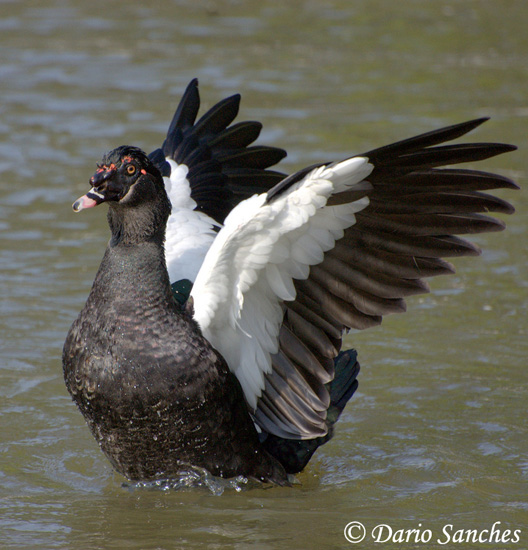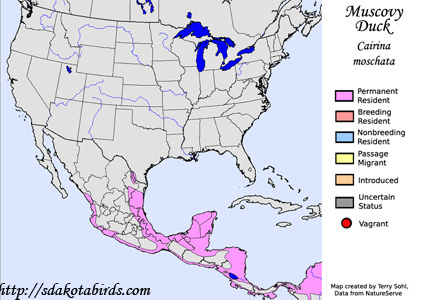| Length: 26-30 inches | Wingspan: 40-48 inches | Seasonality: Non-resident in South Dakota |
| ID Keys: Dark overall, warty face on males, bright white on underwings usually only seen when flying | ||
 The
Muscovy Duck is well known to many, but for most people, it is the
domesticated version to which they are familiar. The true, wild
Muscovy Duck is a bird of the tropical Americas, and is a wary and wild
bird. Wild Muscovy Ducks have a plumage that is nearly all dark,
except for brilliantly white feathers under the wings. Domesticated
versions of the species may have a very wide array of plumages, but
generally include more white or other colors than the all-dark wild Moscovy
Ducks. The normal breeding range of the wild Muscovy Duck normally
reaches just into northern Mexico, but there are occasional, wild, breeding
Muscovy Ducks in the far southern portion of Texas. It is extremely
likely that Muscovy Ducks spotted elsewhere in the United States have a
domestic origin.
The
Muscovy Duck is well known to many, but for most people, it is the
domesticated version to which they are familiar. The true, wild
Muscovy Duck is a bird of the tropical Americas, and is a wary and wild
bird. Wild Muscovy Ducks have a plumage that is nearly all dark,
except for brilliantly white feathers under the wings. Domesticated
versions of the species may have a very wide array of plumages, but
generally include more white or other colors than the all-dark wild Moscovy
Ducks. The normal breeding range of the wild Muscovy Duck normally
reaches just into northern Mexico, but there are occasional, wild, breeding
Muscovy Ducks in the far southern portion of Texas. It is extremely
likely that Muscovy Ducks spotted elsewhere in the United States have a
domestic origin.
Habitat: Found in a variety of aquatic habitats, including tropical swamps, other forested wetlands, and herbaceous wetlands, and water bodies.
Diet: Omnivorous, feeding on both plant and animal matter. Will feed on aquatic plants (seeds, stems, roots, and leaves), small mollusks and crustaceans, and insects and spiders. Will occasionally feed on small vertebrates such as small amphibians, lizards, and fish.
Behavior: Dabbles in shallow water, or feeds on land.
Nesting: Prefers to nest in tree cavities or other cavities, although they will also sometimes nest in heavy vegetation. The male Muscovy Duck may breed with multiple females. Females alone incubate eggs and raise young.
Song: Generally silent, but the males do occasionally emit a whistling sound.
Migration: Considered a permanent resident through its normal range.
Interactive eBird Map: Click here to access an interactive eBird map of Muscovy Duck sightings
Similar Species: Distinctive if seen well.
Conservation Status: There are currently no perceived major threats to Muscovy Duck populations, and the IUCN cites it as a species of "Least Concern".
Further Information: 1) Cornell's Neotropical Birds - Muscovy Duck
2) Avian Web - Muscovy Duck
3) IUCN Red List - Muscovy Duck
Photo Information: Photo taken by Dario Sanches - Llicensed under Creative Commons Attribution Share-Alike 2.0 Generic License
| Click below for a higher-resolution map |
 |
| South Dakota Status: Non-resident in South Dakota |
Additional Muscovy Duck Photos (coming soon!!)
